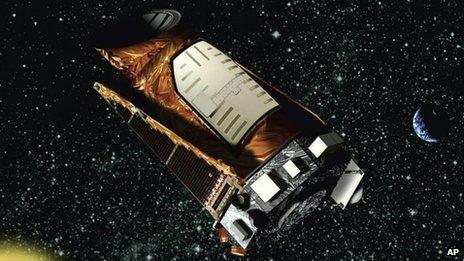Nasa's Kepler telescope hobbled by faulty wheel
- Published

The Kepler telescope, which detects planets outside our solar system, has already completed its primary mission
The planet-hunting space telescope Kepler has been hobbled by a broken wheel, say scientists at Nasa.
Two of four reaction wheels are now faulty. At least three are needed to orient the telescope correctly.
"I wouldn't call Kepler down and out just yet," said Nasa administrator John Grunsfeld, saying scientists were working on the problem.
Kepler was launched in 2009 and last month identified two distant planets that Nasa said could be habitable.
So far, the $600m (£395m) mission has identified 132 "exoplanets" outside our solar system, and another 2,700 possible candidates.
But last July one of the spacecraft's four reaction wheels broke down, leaving scientists aware that a further failure was likely and would prevent the telescope operating as it should.
In a statement, external, Nasa said the problem had been detected on Tuesday, when the telescope went into a pre-programmed "safe mode" which kicks in "if the observatory has trouble knowing where it should point", Mr Grunsfeld told AFP news agency.
The team's priority now is to put the craft into "Point Rest State" - reducing fuel consumption so the craft has enough left to last months or years, giving scientists the time to decide how to proceed.
Kepler completed its primary three-and-a-half year mission last November, Nasa says, and is now in an extended mission phase.
The US space agency says the telescope has generated a wealth of data which could generate new discoveries for years to come.
Last month, scientists announced that Kepler had discovered two of the most intriguing candidates yet in the search for Earth-like exoplanets.
They orbit the Kepler-62 star in the Constellation Lyra - 1,200 light-years from Earth.
- Published19 April 2013
- Published19 April 2013
- Published15 March 2013
- Published20 February 2013
- Published20 December 2011
- Published23 November 2011
- Published25 December 2012
- Published16 January 2012
- Published9 January 2012